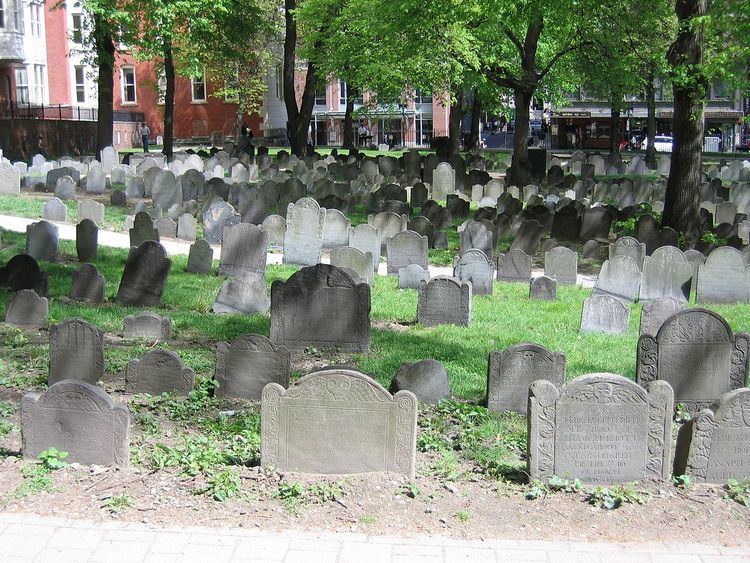Established 1660 Type Historical No. of graves 2,345 | Country United States Owned by City of Boston Founded 1660 | |
 | ||
Address Tremont St, Boston, MA 02108, USA Hours Open today · 9AM–5PMSaturday9AM–5PMSunday9AM–5PMMonday9AM–5PMTuesday9AM–5PMWednesday9AM–5PMThursday9AM–5PMFriday9AM–5PM Similar Old State House, Park Street Church, Old South Meeting House, King's Chapel, Freedom Trail | ||
Creepy places of new england old granary burying ground
The Old Granary Burial Ground in Massachusetts is the city of Boston's third-oldest cemetery, founded in 1660 and located on Tremont Street. It is the final resting place for many notable Revolutionary War-era patriots, including Paul Revere, the five victims of the Boston Massacre, and three signers of the Declaration of Independence: Samuel Adams, John Hancock, and Robert Treat Paine. The cemetery has 2,345 grave-markers, but historians estimate that as many as 5,000 people are buried in it. The cemetery is adjacent to Park Street Church and immediately across from Suffolk University Law School.
Contents
- Creepy places of new england old granary burying ground
- Boston history in a minute granary burying ground
- History
- Memorials and monuments
- Notable burials
- References
The cemetery's Egyptian revival gate and fence were designed by architect Isaiah Rogers (1800–1869), who designed an identical gate for Newport's Touro Cemetery.
Boston history in a minute granary burying ground
History
The Burying Ground was the third cemetery established in the city of Boston and dates to 1660. The need for the site arose because the land set aside for the city's first cemetery—King's Chapel Burying Ground, located a block east—was insufficient to meet the city's growing population. The area was known as the South Burying Ground until 1737, at which point it took on the name of the granary building which stood on the site of the present-day Park Street Church. In May 1830, trees were planted in the area and an attempt was made to change the name to “Franklin Cemetery” to honor the family of Benjamin Franklin, but the effort failed.
The Burying Ground was originally part of the Boston Common, which then encompassed the entire block. The southwest portion of the block was taken for public buildings two years after the cemetery was established, which included the Granary and a house of correction, and the north portion of the block was used for housing.
Tombs were initially placed near the back of the property. On May 15, 1717, a vote was passed by the town to enlarge the Burying Ground by taking part of the highway on the eastern side (now Tremont Street). The enlargement was carried out in 1720 when 15 tombs were created and assigned to a number of Boston families.
Eleven large European elms fronted it on Tremont Street. The elms were planted in 1762 by Major Adino Paddock and John Ballard and reached ten feet in circumference by 1856. The walk under the elms was known as "Paddock's Mall," while the rest of the grounds were devoid of any trees at all. The first major improvement was undertaken in 1830, when a number of trees were planted around the grounds. The property was improved again in 1840 by the construction of an iron fence on Tremont Street. The fence was designed by Boston architect Isaiah Rogers at a cost of $5,000, half paid by the city and half by public subscription. Rogers designed an identical Egyptian revival gateway for Newport's Touro Cemetery.
In January 2009, a previously unknown crypt was discovered when a tourist on a self-guided tour through the cemetery fell through the ground into what appeared to be a stairway leading to a crypt. The stairway had been covered with a piece of slate which eventually gave way due to advanced age. (The tourist was not hurt, nor did she come into contact with any human remains.) The crypt is reported to be 8 by 12 feet and is structurally intact. It is possibly the resting place of Jonathan Armitage, a Boston selectman from 1732 to 1733. Officials from the City of Boston announced in May, 2011 a $300,000 refurbishment project designed to repair and restore the historic site, including widening paths in the cemetery and providing new observation sites. $125,000 will be provided by the Freedom Trail Foundation and the city will pay the rest.
Memorials and monuments
Prominently displayed in the Burying Ground is an obelisk erected in 1827 to the parents and relatives of Benjamin Franklin who was born in Boston and is buried in Philadelphia. Franklin's father was Josiah Franklin, originally from Ecton, Northamptonshire, England, and his mother was Abiah, who was born in Nantucket and was Josiah's second wife. Constructed of granite from the Bunker Hill Monument quarry, the obelisk was constructed to replace the original Franklin family gravestones which had been in poor condition. The new memorial was dedicated on 15 June 1827.
The oldest memorial in the yard lies near the Franklin monument memorializing John Wakefield, aged 52 who died 18 June 1667. The reason(s) for the seven-year gap between the establishment of the burying ground and the oldest memorial are unknown.
Near the Tremont Street entrance are the ashes of the American casualties in the Boston Massacre which occurred 5 March 1770. The grave markers were moved during the 1800s to be in straight lines, to conform to nineteenth century ideas of order, as well as to allow for more modern groundskeeping (i.e., the lawn mower).
